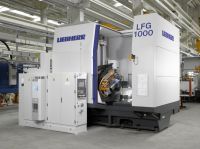IMTS Preview: Liebherr Gear Technology
The LFG1000 CNC Gear Profile-Grinding Machine, and the LCS 500 CNC Gear Generating- and Profile- Grinding Machine, which are ready to use the latest, and proven, grinding technology in the marketplace will be featured at IMTS 2012. Both gear grinding machine types are good for machine shops which have to produce a single part or higher batch sizes. Liebherr offers several technologies including gear hobbing, profile milling, gear shaping, generating- and profile-gear grinding.
Recently, Liebherr's engineering and sales team weighed in on the trends that are driving innovation in gear manufacturing today and the technologies that will be available at IMTS. "On profile and generating grinding, most gear manufacturers need the possibility to create gear flanks with special topological modifications on a high quality level. With these modifications, it is possible to increase the load-carrying capacity of gears, and also to reduce the gear noise behavior," says Dr.-Ing. Andreas Mehr, technology engineer, Liebherr-Verzahntechnik GmbH in Kempten, Germany. "We see this trend on all gears, from the small module gears used in automotive, to the larger ones used in trucks and tractors, and even up to the course pitch applications for wind energy and heavy industrial transmissions. If you can grind these topological gears in addition with a higher efficiency, for example: with dressable CBN tools, or generating-grinding of large module (up to module 14 mm with our LCS 700, 1200), instead of profile grinding, then these customers will have a big productivity advantage against their competition."
"The need for chamfering and deburring of gears in the green manufacturing process chain has led to innovative integrated chamfering + deburring systems within gear hobbing machines," says Scott Yoders, vice president sales at Liebherr Gear Technology, Inc. "In this regard, years ago Liebherr successfully introduced ChamferCut-Technology (together with the cutting tool company LMT-Fette) to industrial mass and medium size production applications. Recently these integrated chamfering systems within the LC- gear hobbing machines have been expanded upon by Liebherr to include separate "parallel-processing" stations such as Rausch-Gratomat, or roll-press deburring. Within the same machine, and with the parallel-processing, the total cycle time for both hobbing and chamfering is not elongated. For coarse pitch gear applications, carbide indexable inserted tools (milling cutters and hobs) have definitely gained more and more importance in North America. Although gear manufacturers' initial investment in hob cutting tools is higher, the productivity due to larger batch sizes is much better, so it pays off. Therefore, for the production of coarse pitch gears, Liebherr hobbing machines equipped for carbide-insert tooling has become more and more the state-of-the-art."
Adds Dr.-Ing. Oliver Winkel, Technology Engineer, Liebherr-Verzahntechnik GmbH, "At Liebherr there has been focus on the reduction of machine idle times, which fits to the trend of decreased cutting times coming from improved cutting tool materials, and technology parameters (speeds, feeds). This means, faster loading/unloading of workpieces, easier setup or changeovers, and measuring within the machine. Lower idle times by faster load and unload, as well as improved control programs, immediately reduces the cost per piece for our Liebherr customers."
"With regards to gear-grinding, the use of dressable CBN, or other powerful abrasives, will have a very important impact, because the grinding time (which influences mainly the workpiece costs per part) is drastically reduced," Mehr says. "Where in the past you may have needed three machines to produce a specific quantity of gears per day, you now would need only one!"





